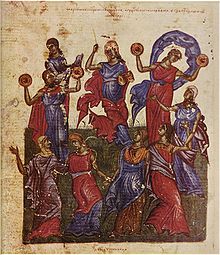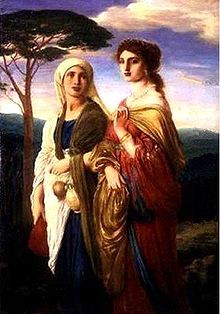- Miriam
-
This article is about the Biblical sister of Moses. For other uses, see Miriam (disambiguation).
Miriam (Hebrew: מִרְיָם, Modern Miryam Tiberian Miryām ; Arabic: مريم (Maryam); see Miriam (given name)) was the sister of Moses and Aaron, and the daughter of Amram and Jochebed. She appears first in the Book of Exodus in the Hebrew Bible.
Contents
Biblical account
At her mother Jochebed's request, Miriam hid her baby brother Moses by the side of a river to evade the Pharaoh’s order that newborn Hebrew boys be killed. She watched as the Pharaoh’s daughter discovered the infant and decided to adopt him. Miriam then suggested that the princess take on a nurse for the child, and suggested Jochebed; as a result, Moses was raised to be familiar with his background as a Hebrew. (Exodus 2:1-10)
Miriam is called a prophetess, and is traditionally believed to have composed a brief victory song after Pharaoh’s army was drowned in the Red Sea (Exodus 15:20-21).
“Sing to the Lord, for he has triumphed gloriously;
Horse and rider he has thrown into the sea.”It is considered by many that this poetic couplet is one of the oldest parts of the Biblical account.
Later, she objected to the marriage of Moses to a Cushite woman, which made her guilty of speaking Lashon hara (gossiping, or speaking negatively about someone), for which she was struck with tzaraat. After Aaron asked Moses to intercede for her, Moses uttered a five-word prayer:“O Lord, make her well,” and she recovered within seven days. (Numbers 12) A passage in Micah suggests she had a legacy with significant regard among later prophets: “And I brought you forth out of the land of Egypt, and redeemed you from the house of bondage, and I sent before you Moses, and Aaron, and Miriam.” (Micah 6:4)
 "And Miriam the prophetess, the sister of Aaron, took a timbrel in her hand; and all the women went out after her with timbrels and with dances." (Exodus 15:20).
"And Miriam the prophetess, the sister of Aaron, took a timbrel in her hand; and all the women went out after her with timbrels and with dances." (Exodus 15:20).
Illuminated manuscript, Tomić Psalter, 1360/63, Moscow State Historical MuseumMarriage
Josephus in Antiquities of the Jews states that Miriam was the wife of Hur, who is mentioned in Exodus as a close companion of Moses.[1] However, in the Targum to I Chron. ii. 19, iv. 4, Miriam is said to be Hur's mother, asserting that Ephrath, the wife of Caleb, was another name for Miriam.
Snow-white Miriam
 Miriam and Aaron confronting Moses.
Miriam and Aaron confronting Moses.
At Hazeroth, Miriam and Aaron speak against Moses because:
- of the Cushite (Ethiopian) woman whom he had married: for he had married a Cushite woman
Miriam and Aaron question Moses’ exclusive religious authority, since they consider themselves to also have been prophets.
- 'They said, 'Was it only to Moses that God spoke? Did he not speak to us as well?
God hears and calls all three to the door of the tabernacle. When they arrive, God states to them that Moses has a much greater authority than Miriam and Aaron; indeed, He chooses to speak to Moses face to face, rather than merely through dreams.
In anger, God subsequently visits a punishment on Miriam, giving her tzaraat turning her “white as snow.” According to the rules concerning tzaraat, Miriam must then live outside of the camp, in isolation, only being allowed back when Moses intercedes with God on her behalf. Nevertheless, God insists that she still be punished for seven days. (Numbers 12:10-14). Tzaraat was an illness traditionally translated to be leprosy, while it really is something more like skin cancer or vitiligo.
Rabbinic Interpretation
According to the Hebrew Bible anyone with tzaraat was tamei (Leviticus 13-14) The Rabbis of the Talmud noted that Aaron did not receive the same punishment as his sister, otherwise he would no longer have been able to perform his duties as high priest.
Form criticism
Zipporah is identified as the wife of Moses, so the traditional Jewish and Christian view is that Zipporah is the woman that Miriam opposes. However, Zipporah is described as being a Cushite from Midian. According to Richard E. Friedman, because Cush refers to Ethiopia (Note: “Ethiopia” in ancient resources refers to the region of Nubia in modern Sudan.) or other lands well outside, the “Cushite woman” of the story is not Zipporah. Friedman, building on interpretations from the documentary hypothesis, notes that Zipporah is only mentioned in the Jahwist text, while the story of Snow-white Miriam is assigned to the Elohist, and so, in each, Moses only ever has one wife.[2]
According to Friedman's interpretation, these two accounts reflected the stories of two different, rival priesthoods, the Aaronid priesthood in the Kingdom of Judah, which claimed descent from Aaron and which controlled the Temple in Jerusalem, and a priesthood based at Shiloh, in the Kingdom of Israel. Friedman, following the tradition of the documentary hypothesis, asserts that various Biblical tales were created or publicized by these factions in order to add an aura of legitimacy to their various claims to privilege and power. According to Friedman, the Elohist was from, or supported, the Shiloh priesthood, and thus had a strong motivation to repeat or create this tale.[2]
Death
According to Numbers 20:1-2, when the Israelites on their journey to the Land of Canaan came into the wilderness of Zin in the first month, and the people stayed in Kadesh, Miriam died and was buried there. True to her symbolism with water, after her death, God opened a spring of abundant water for the people, called Meribah. Unfortunately, this happened after the Israelites contended with God, also resulted in Moses and Aaron committing sin that prevented them to enter Canaan.(Numbers 20:7-13)
Miriam in Jewish culture
The poetic couplet in Exodus 15 is considered by many to be one of the oldest parts of the Biblical account. Rashi’s commentary on this verse, based on the Mekhilta (Be-Shalah, ch. 10), states “Moses chanted a song for the men; he would chant for them and they would answer him. And Miriam chanted a song for the women.” In other words, the Song on the Sea was recited twice, for the men and the women in parallel. Moses chanted the song in its entirety for the men, who answered him in refrain, and Miriam repeated this procedure for the women.
Miriam is a popular figure among some Jewish feminists. Some place a “Cup of Miriam,” filled with water, beside the customary “Cup of Elijah” (filled with wine) during the Passover Seder. The cup contains water in memory of Miriam's well, which according to a Midrash (see Ginzberg, Legends of the Jews 3, 50-54) accompanied the Israelites on their journey through the desert. Some Modern Orthodox[who?] Jews have revived a millennium-old custom of adding a piece of fish to the seder plate, with the lamb, egg and fish jointly symbolizing the three prophets referred to in Micah 6:4, and also alluding to the mythical beasts (the bird Ziz, the animal Behemoth, and the sea-creature Leviathan) which, according to Midrash, are to be served at the Seudat Chiyat HaMatim, the feast for the righteous following the resurrection of the dead, which the Passover Seder (and the Cup of Elijah) allude to. The fish represents Leviathan as well as Miriam and is also a water symbol.[3]
Quranic account
Further information: Biblical narratives and the Qur'an #Miriam and MaryMiriam is mentioned but not named in the Qur'an, and as in the Hebrew Bible, she obeys her mother's request to follow the baby Moses as he floats down the river in a basket, their mother having set him afloat so he would not be killed by the Pharaoh's servants and soldiers (28:11). Later on, the wife of the Pharaoh finds Moses at the river and adopts him as her own, but Moses refuses to be suckled by her. Miriam asks the Pharaoh's wife and her handmaidens to have his own mother act as nursemaid to Moses, the mother's identity not being known to the Pharaoh's wife (28:12–13).
People in the Quran Individuals Aaron · Abel · Abraham · Abu Bakr · Abū Lahab · Adam · Amram · Anne · Asiya · Azar · Azrael · Believer of Ya-Sin · Benjamin · Cain · Caleb · David · Devil · Dhul-Kifl · Dhul-Qarnayn (Cyrus the Great, Alexander the Great) · Elijah · Elisha · Elizabeth · Eve · Ezra · Gabriel · Gog · Goliath · Haman · Harut · Hud · Idris · Isaac · Ishmael · Jacob · Jesus · Jethro · Joachim · Job · Jochebed · John the Baptist · Jonah · Joseph · Joshua · Khidr · King of Abraham's time · Korah · Lot · Luqman · Luqman's son · Maalik · Magog · Mary · Marut · Michael · Miriam · Moses · Muhammad · Noah · Pharaoh of Joseph's time · Pharaoh of the Exodus · Potiphar · Queen of Sheba · Saleh · Samiri · Samuel · Sarah · Saul · Shoaib · Solomon · Umm Jamil · Wicked man, Parable · Wondering man, Parable · Zachariah · Zaid · Zipporah · ZulaikhaGeneral groups Specific Groups Disciples of Jesus · Jinns of Solomon · Muhammad's wives · Scribes of the Quran · People of the Cave · Pharaoh's sorcerers · Twelve Tribes of IsraelCommunities ʿĀd · Companions of the Elephant · Companions of the Rass · Egypt · · Israelites · Mesopotamia · Midian · Nineveh · Sodom and Gomorrah · Thamud · People of Tubba · People of the Wood · People of Ya-Sin · Quraysh · RomansLifeforms Note: Italics denote that the name of the figure is not mentioned in the Quran, but is taken from other sources of Islamic literature.Prophets in the Hebrew Bible Pre-Patriarchs (Bible) Patriarchs and Matriarchs Israelite prophets
in the TorahProphets mentioned
in the Former ProphetsMajor Prophets Minor Prophets Noahide prophets Other prophets Italics denote that the status as a prophet is not universally accepted. · rl are articles dealing with the prophet within Rabbinic Literature.Holy Women in Islam Generations of Adam Generations of Abraham and his sons Generation of Moses Reign of Kings House of Amram Time of Muhammad Early Sufism Rabia of BasraReferences
- ^ Antiquities, Book 3, ch. 1
- ^ a b Richard E. Friedman (May 1997). Who Wrote the Bible?. San Francisco: Harper. pp. 78, 92. ISBN 0-06-063035-3.
- ^ Where is Miriam on the Seder plate? Yael Levine, Edah, YNet News.com, 2006-11-04. Retrieved 2007-05-13.
Categories:- Prophets of the Hebrew Bible
- Old Testament female saints
- Levites
- Torah people
- Judaism and women
- Burials in Tiberias
- Book of Exodus
Wikimedia Foundation. 2010.

